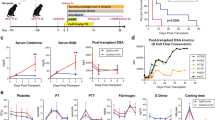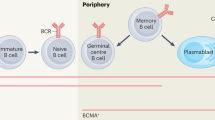Abstract
CD154 is the ligand for the receptor CD40. This ligand–receptor pair mediates endothelial and antigen-presenting cell activation, and facilitates the interaction of these cells with T cells and platelets. We demonstrate here that administration of a CD154-specific monoclonal antibody (hu5C8) allows for renal allotransplantation in outbred, MHC-mismatched rhesus monkeys without acute rejection. The effect persisted for more than 10 months after therapy termination, and no additional drug was required to achieve extended graft survival. Indeed, the use of tacrolimus or chronic steroids seemed to antagonize the anti-rejection effect. Monkeys treated with antibody against CD154 remained healthy during and after therapy. The mechanism of action does not require global depletion of T or B cells. Long-term survivors lost their mixed lymphocyte reactivity in a donor-specific manner, but still formed donor-specific antibody and generated T cells that infiltrated the grafted organ without any obvious effect on graft function. Thus, therapy with antibody against CD154 is a promising agent for clinical use in human allotransplantation.
This is a preview of subscription content, access via your institution
Access options
Subscribe to this journal
Receive 12 print issues and online access
$209.00 per year
only $17.42 per issue
Buy this article
- Purchase on Springer Link
- Instant access to full article PDF
Prices may be subject to local taxes which are calculated during checkout






Similar content being viewed by others
References
Lederman, S. et al. Identification of a novel surface protein on activated CD4+ T cells that induces contact-dependent B cell differentiation (help). J. Exp. Med. 175, 1091–1101 (1992).
Laman, J.D., Claassen E. & Noelle, R.J. Functions of CD40 and its ligand, gp39 (CD40L). Crit. Rev. Immunol. 16, 59–108 (1996).
Larsen, C.P. & Pearson, T.C. The CD40 pathway in allograft rejection, acceptance, and tolerance. Curr. Opin. Immunol. 9, 641–647 (1997).
Harlan, D.M. & Kirk, A.D. Anti-CD154 therapy to prevent graft rejection. Graft 1, 63– 70 (1998).
Henn, V. et al. CD40 ligand on activated platelets triggers an inflammatory reaction of endothelial cells. Nature 391, 591– 594 (1998).
Caux, C. et al. Activation of human dendritic cells through CD40 crosslinking. J. Exp. Med. 180, 1263–1272 (1994).
Karmann, K. et al. CD40 on human endothelial cells: inducibility by cytokines and functional regulation of adhesion molecule expression. Proc. Natl. Acad. Sci. USA 92, 4342–4346 (1995).
Kirk, A.D. et al. CTLA4-Ig and anti-CD40 ligand prevent renal allograft rejection in primates. Proc. Nat. Acad. Sc. USA 94, 8789–8794 (1997).
Bennett, S.R.M. et al. Help for cytotoxic-T-cell responses is mediated by CD40 signalling. Nature 393, 478–480 (1998).
Schoenberger, S.P. et al. T-cell help for cytotoxic T lymphocytes is mediated by CD40-CD40L interactions. Nature 393, 480– 443 (1998).
Ridge, J.P., Di Rosa, F. & Matzinger, P. A conditioned dendritic cell can be a temporal bridge between a CD4+ T-helper and a T-killer cell. Nature 393, 474–477 ( 1998).
Pirsch, J.D. Long-term management of immunosuppression in the renal transplant patient. Curr. Opin. Organ. Transplant 2, 76– 81 (1997).
Auphan N. et al. Immunosuppression by glucocorticoids: inhibition of NF-κB activity through induction of IκB synthesis. Science 270, 286–290 (1995).
Plaz, K.P. et al. RS-61443, a new, potent immunosuppressive agent. Transplantation 51, 27–31 (1991).
Fruman, D.A., Klee, C.B., Bierer, B.E. & Burakoff, S.J. Calcineurin phosphatase activity in T lymphocytes is inhibited by FK506 and cyclosporin A. Proc. Natl. Acad. Sci. USA 89, 3686– 3690 (1992).
Lederman, S.G. et al. Molecular interactions mediating T-B lymphocyte collaboration in human lymphoid follicles: roles of the T-Cell-B-Cell activating molecule (5c8 antigen) and CD40 in contact dependent help. J. Immunol. 149, 3817–3826 (1992).
Yang, Y. & Wilson, J.M. CD40 ligand-dependent T cell activation: requirement of B7-CD28 signaling through CD40. Science 273, 1862–184 (1996).
Konieczny, B.T. et al. IFN-γ is critical for long-term allograft survival induced by blocking the CD28 and CD40 ligand T cell costimulation pathways. J. Immunol. 160, 2059–2064 (1998).
Markees, T.G. et al. Long-term survival of skin allografts induced by donor splenocytes and anti-CD154 antibody in thymectomized mice requires CD4+ T cells, interferon-gamma, and CTLA4. J. Clin. Invest. 101, 2446–2455 (1998).
Knapp, L.A. et al. High-resolution HLA-DRB typing using denaturing gradient gel electrophoresis and direct sequencing. Tissue Antigens 50, 170–177 (1997).
Knechtle, S.J. et al. FN18-CRM9 immunotoxin promotes tolerance in primate renal allografts. Transplantation 63, 1– 6 (1997).
Kirk, A.D. et al. Post-transplant diastolic hypertension: associations with intragraft TGF-β, endothelin and renin transcription. Transplantation 64, 1716–1720 ( 1997).
Kirk, A.D., Bollinger, R.R. & Finn, O.J. Rapid, comprehensive analysis of human cytokine mRNA and its application to the study of acute renal allograft rejection. Hum Immunol. 43, 113–128 (1995).
Acknowledgements
The authors acknowledge the technical assistance of D.L. Doctor, G. Garth and J. Hyde, the photographic assistance of L. Duckett and the veterinary care provided by M. Chartier and P.J. Rico. This work was supported by Naval Medical Research and Development Command Grant EW.0095.003.1412, Office of Naval Research Grant N00014-96-1-1282, and Biogen. The views expressed in this article are those of the authors and do not reflect the official policy of the Department of the Navy, the Department of Defense nor the United States Government.
Author information
Authors and Affiliations
Rights and permissions
About this article
Cite this article
Kirk, A., Burkly, L., Batty, D. et al. Treatment with humanized monoclonal antibody against CD154 prevents acute renal allograft rejection in nonhuman primates. Nat Med 5, 686–693 (1999). https://doi.org/10.1038/9536
Received:
Accepted:
Issue Date:
DOI: https://doi.org/10.1038/9536



